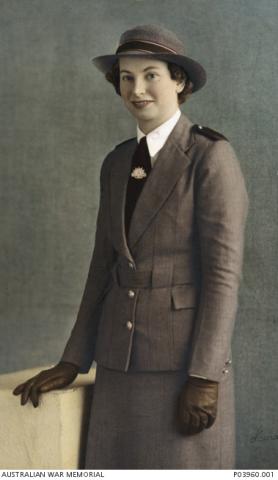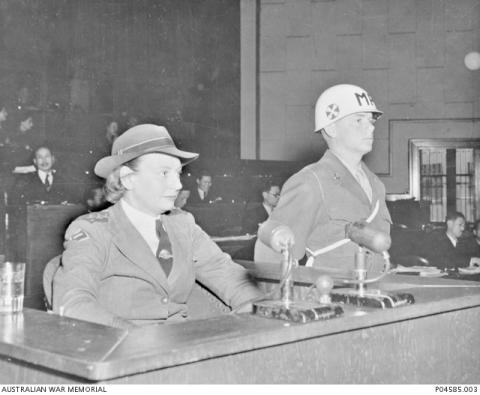Vivian Bullwinkel
The following account is based on the Australian War Memorial's Guide to the papers of Vivian Bullwinkel.

In 1941, aged 26, Vivian Bullwinkel enlisted in the Australian Army Nursing Service, AIF. She reported for duty in May and sailed for Singapore in September as a Staff Nurse with the newly formed 2/13th Australian General Hospital. She served there until February 1942, when she and 64 other nurses were evacuated aboard the Vyner Brooke.
On 14 February, while bound for Sumatra via the Bangka Strait, the ship was sunk by Japanese bombers. Bullwinkel later described the attack:
“Beautiful sunny morning, calm sea, and anchored very pretty island. Peacefulness disturbed as planes flew over and machine-gunned boat, all took to lower deck as pre-arranged, but raid all over and much discussion on planes sinking us and enemy aircraft. Took up anchor and steamed along. 2 pm air raid siren. All down to lower deck and flatten down. Six planes attacking once more, bombs hit, second, third time, third bomb below the water line. Whistle for all on deck to take to life boats. Wight, Nourse, Cuthbertson, several civilians injured ...'”
She survived the sinking and reached Bangka Island with other survivors. A Japanese patrol found the group and ordered 22 women to wade into the sea, then machine-gunned them from behind. Bullwinkel alone survived.
For nearly two weeks she hid in the jungle, caring for a wounded British soldier before surrendering. She rejoined other surviving Sisters, who spent three and a half years as prisoners of war on Bangka Island and Sumatra. Of the 65 nurses evacuated from Singapore, only 24—including Bullwinkel—returned to Australia. Eight died in the last seven months of captivity from malnutrition and preventable disease.

In December 1946 Bullwinkel testified at the Tokyo War Crimes Trials, where she was commended as a model witness. After the war she continued at Heidelberg Military Hospital, later under the Department of Repatriation, and became Assistant Matron. From 1955 to 1970 she served as Lieutenant Colonel in the 3rd Royal Australian Nursing Corps Training Unit (CMF).
Retiring in 1977 as Director of Nursing at Fairfield Infectious Diseases Hospital, she helped evacuate Vietnamese war orphans from Saigon and oversaw their recovery before adoption in Australia. She was active in the Red Cross and ex-service organisations and established scholarships for Malaysian nurses to complete training in Australia.
Bullwinkel received many honours, including selection in The People Who Made Australia (Bicentennial publication, 2000), and a Federal Seat in her name. She married Colonel Francis West Statham in 1977 and, in 1992, returned to Bangka Island to choose a site for a memorial. Its dedication in 1993 fulfilled her long-held wish to honour her fallen colleagues.
Selected Reading
https://www.awm.gov.au/collection/P10676383
Claire Hunter, "There was no mistaking their vicious intensions," on https://www.awm.gov.au/articles/blog/vivian-bullwinkel
ABC Documentary Vivian Bullwinkel An Australian Heroine DVD Trailer https://www.youtube.com/watch?v=o9H6oJx5bD8
https://www.awm.gov.au/collection/accessing-records-at-the-memorial/findingaids/private/bullwinkel
Title: Papers of Vivian Bullwinkel
Date range of collection: 1916-1998
Collection number: PR01216
Extent: 1.8 shelf metres, 7 boxes, 19 albums, 6 oversized (flat stack) folios
Location: Private Records collection, Research Centre, Australian War Memorial.
Abstract: The collection comprises Bullwinkel's diaries and notebooks covering 1941-1942; postcards, albums of correspondence relating to her experience as an Australian Army Sister; original transcripts based on her testimony at the Tokyo war trials in 1946; photographs, news cuttings, letters and ephemera relating to her postwar career which included work with the Red Cross and ex-service, nursing and other voluntary organisations.

Add new comment